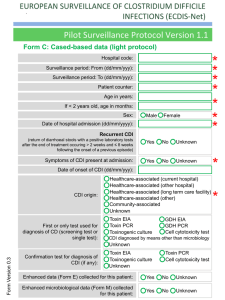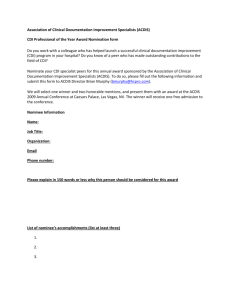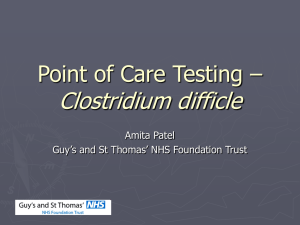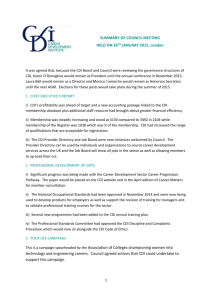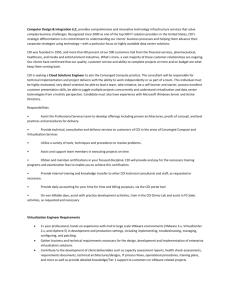Guidance Tool for the investigation of severe Clostridium difficile
advertisement
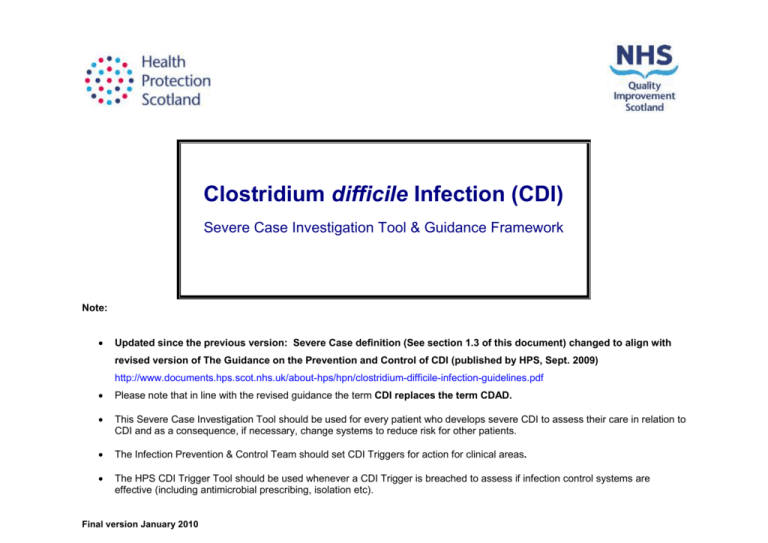
Clostridium difficile Infection (CDI) Severe Case Investigation Tool & Guidance Framework Note: Updated since the previous version: Severe Case definition (See section 1.3 of this document) changed to align with revised version of The Guidance on the Prevention and Control of CDI (published by HPS, Sept. 2009) http://www.documents.hps.scot.nhs.uk/about-hps/hpn/clostridium-difficile-infection-guidelines.pdf Please note that in line with the revised guidance the term CDI replaces the term CDAD. This Severe Case Investigation Tool should be used for every patient who develops severe CDI to assess their care in relation to CDI and as a consequence, if necessary, change systems to reduce risk for other patients. The Infection Prevention & Control Team should set CDI Triggers for action for clinical areas. The HPS CDI Trigger Tool should be used whenever a CDI Trigger is breached to assess if infection control systems are effective (including antimicrobial prescribing, isolation etc). Final version January 2010 Contents Section 1: CDI Introduction and context 1.1 Introduction 1.2 Purpose of Guidance Framework and Investigation Tool 1.3 Definition of a Severe Case of CDI 1.4 General Principals for the Investigation of Severe CDI Cases 1.5 Monitoring and Review of Severe CDI events 1.6 Quality Improvement and Associated Actions Section 2: CDI Severe Investigation Tool Part 1: Assessment of the individual patient care Part 2: System Assessment Appendix 1 CDI Severe Case Investigation Tool Flowchart: When to use it and what to do This flowchart can be used for display as a quick-reference guide for when and how to use the tool 2 Final version January 2010 Section 1 CDI Introduction and Context 1.1 Introduction Healthcare can present a serious risk to patient safety, particularly when it results in healthcare associated infections (HAIs). Every patient needs to be confident that the care and treatment they receive is safe and meets the highest standard possible. Patients also need to be assured that serious infections associated with healthcare are thoroughly investigated and, where necessary, systems and processes improved including lessons shared and learnt To ensure optimal patient safety it is highly recommended that the framework and investigation tool are integrated and embedded into the NHS Boards clinical governance and risk management processes, systems and structure i.e. the tool should be included in the Adverse Incidents and Escalation Policy. Clinical Team Responsibility Each NHS Board should determine locally how they will ensure that all the patients who meet the severe disease definition (as defined in section 1.3) are identified, and that this identification system is robust. Each NHS Board will identify the trigger as to how the framework and tool will be used if a patient has been identified as meeting the definition. 3 Final version January 2010 1.2 Purpose of Guidance Framework and Investigation Tool The purpose of the Investigation tool and guidance framework is to support the investigation of a severe case or cases of Clostridium difficile Infection (CDI) cases(s) in order to: 1.3 Identify if the patient’s care was the best possible identify if the patient’s clinical care and overall management was optimum Identify if any improvements can be made Make it safer for all patients Determine what can be improved to reduce the risk of future patients developing severe CDI infection and subsequent more severe disease Definition of a severe case of CDI A case of severe CDI should always be considered a significant clinical incident for any clinical team and merit detailed investigation in order to improve, review systems and processes. A severe case of CDI is defined as any patient with CDI who: o Has, or had, two or more severity markers, i.e. temperature >38.5°C, WBC > 15 cells/mm3, creatinine > 1.5 x baseline, suspicion of PMC, toxic megacolon, ileus, or CT evidence of severe disease. o Has died within 30 days following a diagnosis of CDI where it is recorded as either the primary or a contributory factor on the death certificate. o Has persisting CDI where the patient has remained symptomatic and toxin positive despite 2 courses of appropriate therapy. 1.4 General principles for the investigation of severe CDI cases All patients with CDI require monitoring for possible development of severe CDI. To ensure that all cases of severe CDI are identified and investigated, CDI care plans and integrated care pathways should enable the clinical team to identify the need for use of this investigation tool (section 2). All CDI cases and potential risks should be reported and graded in accordance with the organisation’s risk matrix. All CDI cases should have a level of investigation that is commensurate with the significance of the event, or the potential significance of a near miss. 4 Final version January 2010 1.5 1.6 Monitoring and Review of Severe CDI events Without regular and sustained monitoring and review of CDI event/case/episode reports, the benefits of such reporting cannot be realised. Each NHS board should have an established broad framework, by which events can be investigated, monitored, trends identified and the effect of events minimised and learned from. NHS boards should ensure there is a process and structure in place to monitor and review individual CDI events and trends. The process and structure should be clearly identified within the NHS Boards Risk Management/Clinical Governance Strategy Quality Improvement and Associated Actions If there are clear recommendations for actions in response to quality issues identified these should be formalised in the NHS Board action plan. It is vital that actions are monitored via local Clinical Governance structures to ensure sharing of any lessons learned and system changes. It is also important to ensure the identification of any emerging trends. The action plan should also consider who in the wider health community could benefit from knowing the lessons learned. Suggestions for wider dissemination of the lessons could include Health Protection Scotland and other national NHS agencies, professional organisations and Higher Education facilities. 5 Final version January 2010 Section 2 CDI Severe Case Investigation Tool The tool is divided into two parts: Part 1: Assessment of the individual patient care The initial review and action must be completed by the clinical team. The clinical team must review the care that was provided to the patient and consider whether everything that could be done, was done, to recognise any fundamental patient risk, to prevent the patient becoming predisposed to CDI, Part 2: The System Assessment – Part 2 should only be completed if the HPS CDI Trigger Tool is NOT in operation Examples of those identified individuals responsible for the assessment and completion of this documentation include the: Infection prevention control team Representation from the clinical team responsible for the patient’s care Antimicrobial team Designated risk manager Lead clinical nurse to assist in the process 6 Final version January 2010 Part 1 Assessment of the individual patient care ! Please refer to section 1.3 above for a definition of a severe case of CDI Patient name Chi. No Date admitted Reason for admission Source of admission Outcome (i.e. date discharged, transferred, died etc) Did this patient have significant co- Date diarrhoea developed morbidities on admission? Was the patient’s Waterlow score >20 Number of admissions in the on admission (if calculated) past 3 months Date CDI diagnosed Date review Review team (state name and profession) Signature(s) On completion of the tool the multi-disciplinary teams should discuss and agree the timetable for any actions to optimise the care of patients in the ward. 7 Final version January 2010 (1) Predisposition and the patient’s intrinsic risk to CDI Question Yes/No Review suggestions If “no” give brief notes as to why How will you improve care in the future? During this admission did the patient e.g. surgical site infection, develop an HAI other than CDI? catheter associated urinary tract infection, infected pressure ulcer Were there any identifiable factors e.g. invasive devices left in situ that contributed to the development too long of this infection(s)? >>>>>>// Continued on next page 8 Final version January 2010 (1) Predisposition and the patient’s intrinsic risk to CDI Question Yes/No Review suggestions If “no” give brief notes as to How will you improve care in the future? why Antibiotics: If antibiotics were used in the 12 Compare policy with the weeks before the patient developed patient’s prescriptions CDI, were they used in line with the local policy? Was the reason for antibiotic use documented? Was antibiotic use reviewed (frequency, duration, dose and type of antibiotic)? Were reasons for any variances from the local policy documented in the patient’s notes? 9 Final version January 2010 (1) Predisposition and the patient’s intrinsic risk to CDI Question Yes/No Review suggestions If “no” give brief notes as to How will you improve care in the future? why Was it possible to have avoided high-risk antimicrobial agents (3rd generation cephalosporins broad spectrum penicillins, clindamycin and fluoroquinolones)? Was there any documented e.g. uncontrolled evidence of exposure to C. difficile? exposure to faeces, exposure to other patients with CDI 10 Final version January 2010 (2) Was everything done to identify that the patient had CDI at the earliest opportunity? Question Yes/No Review suggestions If “no” give brief notes as to How will you improve care in the future? why Was a stool specimen obtained as Compare time of onset of soon as the first onset of symptoms symptoms to time specimen and/or admission of patient with sent diarrhoea?(after one or two loose stools) Did the ward receive a prompt result from the laboratory lll Review time form specimen in lab to information being received on the ward that the patient was positive Was there any delay in implementing Review time from measures (SICPs and antimicrobial information being received review) as a result of a positive report on the ward that the patient from the laboratory was positive to active interventions being applied 11 Final version January 2010 (3) Once CDI was diagnosed, was everything done to optimise the care of the patient and reduce the risk of complications? Question Yes/No Review suggestions If “no” give brief notes as How will you improve care in the future? to why Once the patient was diagnosed with CDI: Was any non-Clostridium difficile Review any action antimicrobial treatment stopped (if documented in the patient’s possible)? notes Was medication that could worsen CDI Review patient’s drug kardex reviewed and (if possible) stopped, e.g. anti-motility agents such as Loperamide? Was the patient assessed for the Disease severity and therapy following CDI severity markers: how should be documented in the often? patient’s notes a) temperature >38.5C b) colonic dilation Daily assessment and stool chart completed c) pseudomembranous colitis d) toxic megacolon e) ileus f) WCC >15X106cells/l g) Creatinine >1.5 X baseline h) albumin <2.5mg/dl – 12 Final version January 2010 (3) Once CDI was diagnosed, was everything done to optimise the care of the patient and reduce the risk of complications? Question Yes/No Review suggestions If “no” give brief notes as How will you improve care in the future? to why If the patient initially had mild to Review patient’s drug kardex moderate disease were they treated (as per national guidance) with oral metronidazole 400mg or 500mg t.d.s. for 10-14 days? Was the patient’s hydration needs Review fluid charts, U&Es, assessed and corrected as appropriate? clinical assessment Was there a daily assessment of the Daily assessment to include patient’s CDI condition? from date of diagnosis until date asymptomatic and stable If after day 5 there was no clinical Vancomycin may be improvement, was metronidazole prescribed first if the patient’s switched to vancomycin 125 mg q.d.s. for disease is initially diagnosed a further 10-14 days? as severe 5 day review documented in the patients’ notes 13 Final version January 2010 (3) Once CDI was diagnosed, was everything done to optimise the care of the patient and reduce the risk of complications? Question Yes/No Review suggestions If “no” give brief notes as How will you improve care in the future? to why Were consultations requested from Consider time to seeking surgery, gastroenterology and referral and, time to referral microbiology depts.? taking place If ileus was detected was 500mg metronidazole IV t.d.s. added to the regimen until the ileus resolved. Was all monitoring continued until the Review patient’s notes patient was symptom free for 48hours? If the patient re-developed symptoms Bowels monitored for after 48hours symptom free, were duration of admission? precautions reintroduced promptly? If the patient developed recurrent disease Review patient’s drug kardex (from third and subsequent episodes), was the treatment regimen as per the national guidance? 14 Final version January 2010 Part 2 Systems Assessment This part of the assessment should be completed by the Infection Control Team and the Lead Clinical Nurse How many patients on average develop CDI on this ward in a year? How many patients were in the ward with CDI when this patient developed symptoms? Number of single rooms on the ward with en suite facilities? Is there sufficient equipment to allow patients with CDI to have dedicated personal equipment? (e.g. commodes) What process data are available? Data on adherence to SOPs, policies and national cleaning services standards Data on hand hygiene Data on cleanliness of equipment Data on antibiotic stewardship Data on failures to isolate CDAD patients Were there any other atypical factors present around the time that patient became ill that could have contributed to the patient developing CDI or severe CDI disease e.g. was there a cluster of cases at the same time? Were the staffing levels reviewed to reflect the patient need? 15 Final version January 2010 Summary Summary Response Any Identified Was everything done to minimise the predisposition to CDI and assess individual patient risk? (particularly infection control measures and optimal antimicrobial prescribing) Was everything done to ensure prompt diagnosis? Was everything done to optimise care once CDI was diagnosed? Consider the findings obtained from the systems assessment review and summarise the main findings below, highlighting any areas where improvements can be made either regarding clinical care or the care environment. 16 Final version January 2010 Action Plan Ref Action Resource Requirements Status Owner Due Completed Date Date Local Actions (within area of incident) Directorate/ Partnership Actions (those actions beyond affected area and across Directorate/ Partnership) Board Actions (those actions to be communicated out with Directorate/ Partnership for further learning) Reference; Guidance on Prevention and Control of Clostridium difficile Associated Disease (CDI) in Healthcare settings in Scotland http://www.documents.hps.scot.nhs.uk/hai/sshaip/guidelines/clostridium-difficile/guidance-CDI-2008-10.pdf 17 Final version January 2010 Appendix 1 ! This flowchart can be used for display as a quick-reference guide for when and how to use the tool Clostridium difficile Infection (CDI) Severe Case Investigation Tool: WHEN TO USE IT AND WHAT TO DO Develop a process to identify CDI Severe Case patients ! Once Severe Case patient (s) has been identified, UTILISE TOOL Undertake an investigation using CDI Severe Case tool if identified uUSEUUSED Identify if the patient’s care and overall management was optimum Identify issues for improvement Develop a plan to change practice and initiate changes Final version January 2010 !
